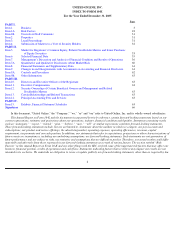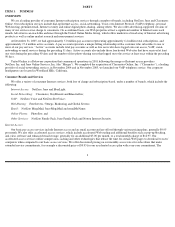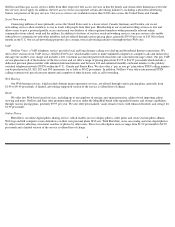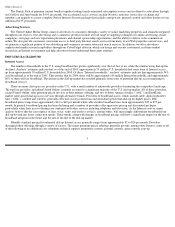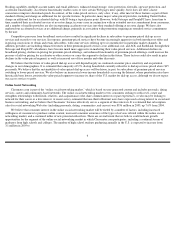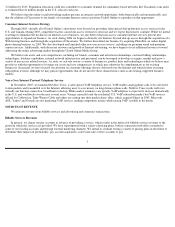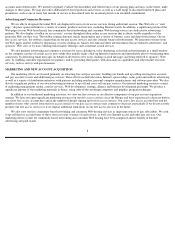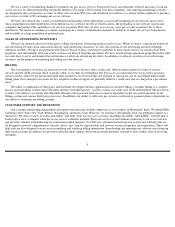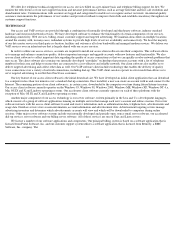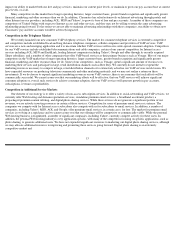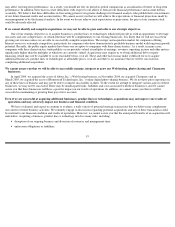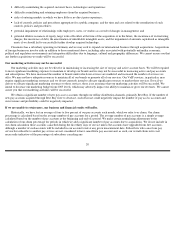Classmates.com 2005 Annual Report Download - page 13
Download and view the complete annual report
Please find page 13 of the 2005 Classmates.com annual report below. You can navigate through the pages in the report by either clicking on the pages listed below, or by using the keyword search tool below to find specific information within the annual report.
COMPETITION
Internet Access Competition
Competition in the Internet access market is intense. We compete with established online service and content providers such as AOL,
AOL’s Netscape subsidiary and MSN; independent national ISPs such as EarthLink and its PeoplePC subsidiary; companies combining their
resources to offer Internet access in conjunction with other services such as Yahoo! and AT&T Internet Services, Yahoo! and Verizon, and AOL
and Walmart.com; national communications companies and local exchange carriers such as AT&T WorldNet, Qwest Communications
International, Inc. and Verizon; cable companies such as Comcast Corporation, Cox Communications, Inc., Charter Communications, Inc. and
Adelphia Communications Corporation; local telephone companies; and regional and local commercial ISPs. Also, a number of municipalities,
such as San Francisco, have announced their intention to make available wireless broadband access services to their communities free of charge
or for discounted fees, and significant companies, including Google, are bidding to provide some or all of these services. While this form of
competition is new and its potential impact unknown, the availability of free or inexpensive wireless broadband services in major metropolitan
markets could have a significant impact upon the industry and on our business.
The number of U.S. households using broadband has grown significantly over the last few years and is expected to continue to grow.
Broadband access, which includes cable, DSL, satellite and wireless, generally offers users faster connection and download speeds than dial-up
access for monthly fees currently ranging from approximately $13 to $55 per month, although offers for promotional periods have been as low as
$10 per month. Pricing for broadband services, particularly for introductory promotional periods, services bundled with cable and telephone
services, and services with slower speeds, has been declining and the pricing gap between broadband and dial-up access services has been
narrowing with, in some cases, premium and value dial-up access services priced at or above pricing for certain broadband services. For
example, Verizon Yahoo! recently offered DSL at $14.95 per month to customers who agree to a one-year commitment and AT&T Yahoo!
recently offered DSL at $12.99 per month to new customers who agree to a one-year commitment. As a result of broadband adoption, the total
number of dial-up accounts in the U.S. has declined and industry analysts predict that it will continue to decline. The decline in the size of the
dial-up market has accelerated and will likely continue to accelerate as broadband services become more widely available at lower prices and
consumer adoption of broadband applications, such as online video, telephony and music downloads, which depend upon connections that
provide significant bandwidth, increases. While we review the possibility of offering broadband services from time to time, including wireless
services, we currently do not plan to offer broadband services on a significant scale, which has adversely impacted, and will continue to
adversely impact, our ability to compete for new subscribers and to retain existing subscribers.
Our success historically has been based on offering dial-up Internet access services at prices below the standard monthly pricing of the
premium dial-up services of most of our major competitors. Competition from broadband providers and value-priced providers such as United
Online has resulted in significant declines in the number of subscribers to premium priced dial-up services over the last few years. In response to
this competition, many competitors have engaged, and may continue to engage, in more aggressive pricing of their dial-up services under their
premium-
priced brands to obtain and retain users, such as offering discounted pricing or extended periods of free service such as six months free.
AOL has previously tested decreased price points on their dial-up service and may continue to do so in the future, although AOL recently
announced a price increase for its premium service. Additionally, AOL, through its Netscape subsidiary, EarthLink, through its PeoplePC
subsidiary, and a number of small providers now offer value-priced services at prices similar to our prices and which are, in some cases, priced
below the prices of our services. Partially in response to this competition, we have become more aggressive in offering discounted services and
one or more free months of services in order to obtain and retain pay
12


